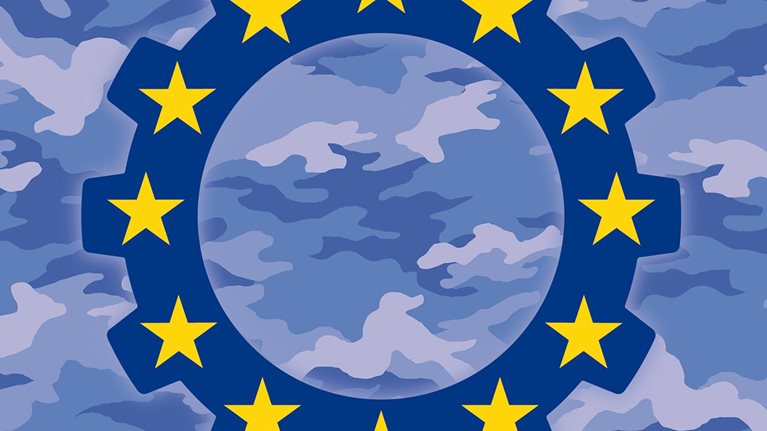As a presidential candidate, Donald Trump suggested that the North Atlantic Treaty Organization (NATO) was “obsolete,”1 casting doubt on America’s commitment to the collective defense of Europe. On the eve of accepting the Republican nomination for president, he went so far as to suggest that the United States would come to the defense of its NATO allies only if they had “fulfilled their [financial] obligations to us.”2 This called into question America’s commitment to one of NATO’s core tenets, collective defense, enshrined in Article 5 of the founding treaty. Shortly after taking office, President Trump revised his view on NATO’s relevance, saying that NATO is no longer obsolete. And just before the July 2017 meeting of the G20, he offered a more vigorous expression of support for Article 5, saying, “The United States has demonstrated with its actions, not just words, that it stands firmly behind Article 5.”3
Stay current on your favorite topics
The question of obsolescence seems to have been settled. But the debate on burden-sharing continues unabated. In his roundabout way, President Trump has done a notable job of raising the issue of the adequacy of European NATO’s defense spending. Criticism has focused almost entirely on the level of investment by member countries—whether they are meeting the 2 percent commitment—with far less attention paid to their actual ability to defend themselves and their allies. All things considered, the 2 percent rule is a poor way to measure burden-sharing. It came about in part as a convenience, as this was the level of NATO Europe’s spending in 2002, when the target was first agreed upon. It is one of the few things that NATO reports externally. It is useful, if a little crude, but it has a few methodological flaws and takes us only so far. Even the wider concept of burden-sharing, the desire for members to “pay their fair share,” is inherently flawed, since it focuses on inputs rather than outputs.
What is needed is a more explicit focus on the capabilities NATO can deploy in the conduct of its core tasks of collective defense, crisis management, and cooperative security, and new metrics to assess these. A much more robust discussion is possible, even with the fairly limited data publicly available today. This paper is my attempt to contribute to that discussion.
Disproportionate spending? The 2 percent obsession
President Trump argues that “NATO is unfair economically to us, to the United States. Because it really helps them more so than the United States, and we pay a disproportionate share.”4 His message has been echoed by senior administration officials. Secretary of Defense James Mattis, in his first meeting with NATO defense ministers in February 2017, warned that the United States could “moderate its commitment” to the alliance if allies did not get serious about meeting the 2 percent goal. “No longer can the American taxpayer carry a disproportionate share of the defense of Western values.”5
A perception of unequal burdens is not a new issue. It is as old as the alliance itself. President Trump is far from alone in calling for NATO members to meet the 2 percent target. A wide array of American officials has pressured our NATO allies to live up to their commitment, not just in this administration but in the prior ones as well.
President Obama complained of “free riders.”6 Former Defense Secretary Robert M. Gates used no less colorful language in his valedictory speech in Brussels, warning of a “dim if not dismal future” for the alliance, pointing to the “very real possibility of collective military irrelevance” and issuing the prescient warning that Americans were beginning to grow tired of expending precious resources defending nations “unwilling to devote the necessary resources . . . to be serious and capable partners in their own defense.”7
The historical roots of the issue run even deeper. Indeed, complaints date back almost to the foundation of the alliance in 1949. In 1953, Secretary of State John Foster Dulles threatened “an agonizing reappraisal” of the US commitment to European security if its allies did not step up.8
Would you like to learn more about our Public Sector Practice?
If nothing else, the 2 percent rule has provided a yardstick to measure the gap that has provoked all the complaints (Exhibit 1). From 1985–1989, NATO Europe spent an average of 3.1 percent of GDP on defense. With the fall of the Berlin Wall in 1989, Western European countries no longer felt an imminent threat from the Warsaw Pact countries and elected to take a “peace dividend.” Spending fell to 2.5 percent in 1990–1994, 2.0 percent in 1995–1999, and 1.9 percent in 2000–2004. Five years later, the average fell yet again, to 1.7 percent. A low point of 1.43 percent (1.40 percent including Canada) was reached in 2015.

Only five member states (Estonia, Greece, Poland, the United Kingdom, and the US) hit the 2 percent benchmark in 2016, and only three of those—the United States, Britain, and Poland—also met NATO’s target of spending 20 percent of their annual defense expenditure on equipment. In 2016, the United States well exceeded the target, spending 3.6 percent of GDP on defense, contributing fully 68 percent of NATO’s combined defense expenditure despite representing only 46 percent of the alliance’s combined GDP.
Some progress, but to what end?
The 2 percent figure dates to the 2002 Prague summit, when it was established as a non-binding target; it was reiterated in Riga in 2006. At the NATO 2014 summit in Wales, all states not meeting the target pledged to do so within the next decade (and states above 2 percent agreed to maintain that level). In the three years since the Wales summit, spending has started to move in the right direction, increasing by 1.8 percent in 2015, 3.3 percent in 2016, and a projected 4.3 percent this year.
Some might argue that the president’s “very strong and frank discussions”9 have begun to pay dividends. It is, however, equally plausible that governments have begun to slowly increase spending not just because of US comments but also because they are reassessing their presumption that Western Europe is safe from outside threats. Several former NATO officials have commented on the rising number of geopolitical challenges.10
And in any event, the recent increases have raised the overall figure only slightly, to 1.47 percent of GDP—an indicator of how much further the European allies must go to recover lost ground. To get to 2 percent, spending will need to increase by another $107 billion annually ($28 billion in Germany, $17 billion in Italy, $15 billion in Spain, $12 billion in Canada, $5 billion in France, and smaller sums elsewhere).
Some question whether 2 percent is still the right target. It would seem so, as the present level of spending is not producing the desired results. Shortfalls in NATO’s fighting power were most graphically illustrated in Libya in 2011. After taking command of the air war there, the alliance ran short of munitions after just 11 weeks, drawing a harsh rebuke from Defense Secretary Robert Gates, who pointed to shortages not just in “boots on the ground, but in crucial support assets such as helicopters, transport aircraft, maintenance, intelligence, surveillance and reconnaissance, and much more.”11
Flawed but indispensable
Many allies question the relevance of the 2 percent target on methodological grounds, citing different methodologies used to calculate national defense spending or calling for related spending to be included. There is no shared understanding of what makes up defense spending. In its definition of “military expenditure,” NATO includes defense ministry budgets, expenditure for peacekeeping and humanitarian operations, and research and development costs. Significantly, it also includes pensions. For many states, military pensions represent a substantial proportion of their defense budget (in 2016, 33 percent of Belgium’s defense budget was spent on pensions, as was 24 percent of France’s and 17 percent of Germany’s). The trouble is that while pensions contribute to the 2 percent target, they do not contribute to a state’s fighting power.12
Others, notably Germany, make the case that non-military contributions to security, such as development aid, or even non-monetary contributions, such as overflight rights or basing, should be taken into account. In March 2017, German Foreign Minister Sigmar Gabriel said that the 2 percent target was neither “reachable nor desirable” for Germany, and that “it is better to talk about better spending instead of more spending.”13 Wolfgang Ischinger, chairman of the Munich Security Conference, suggests a broader 3 percent target for crisis prevention, development assistance, and defense.14
Finally, some argue that the United States’ status as a global power means that its defense spending is not directly comparable to that of other NATO members. Of nearly 200,000 US forces deployed overseas, just over 99,000 of them are deployed in Europe, suggesting that roughly half of US deployed forces (and by extension roughly half its spending) are dedicated to non-European missions.15 By that measure, the US contribution to NATO would not seem nearly so disproportionate.
For all of those problems, the 2 percent metric retains its appeal. It is simple, straightforward, and (relatively) easy to measure. Jan Techau, director of Carnegie Europe, argues that the 2 percent target is “flawed but indispensable” as a measure of “who is and who is not politically committed to NATO’s core task: Europe’s security.”16
Current metrics inadequate
In addition to defense spending as a percent of GDP, and the percent of that spending dedicated to major equipment purchases, NATO has set a number of other targets for defense output. At the Riga summit in 2006, it introduced a target that NATO land forces be at least 40 percent deployable and 8 percent deployable on a sustained basis (raised to 50 percent and 10 percent in 2008).17 In 2011, NATO went further, developing a more detailed set of output metrics—nine in all, focused on deployability, sustainability, and numbers of deployed air, land, and maritime forces.
NATO member states’ performance on these metrics remains classified, with the notable exception of Denmark.18 However, some of these same figures are publicly reported by the European Defense Agency (EDA) (22 members are common to NATO and the EDA). The latest official figures from the EDA show that only 29 percent of EDA member forces are deployable, and less than 6 percent of them on a sustainable basis,19 with unofficial figures suggesting that fewer than 3 percent of European troops are deployable due to a lack of interoperability and equipment shortages.20

Agility in US national security
Yet even these numbers, while more revealing than the blunt instrument of the 2 percent rule, do not provide a full picture of NATO’s health. The current set of metrics is inadequate to determine whether alliance members are spending enough and on the right things, and generating real combat power as a result. While measuring such attributes is of course more difficult, and the data harder to obtain, the fact remains that there is enough information in the public domain for a robust discussion.
Expect what you inspect
“There is too much focus on the ‘input’ (how much the member states spend) and too little focus on the ‘output’ (how much they get out of it),” says Magnus Petersson, the head of the Centre for Transatlantic Studies at the Norwegian Institute for Defence Studies. The Center for a New American Security argues that what matters is not just how much a nation spends on defense, but what it spends it on, and—critically—its willingness to use it.21 Jan Techau, former director of Carnegie Europe, says it all: “Spending at 2 percent says very little about a country’s actual military capabilities; its readiness, deployability, and sustainability levels; and the quality of the force that it can field. It also is mum about a country’s willingness to deploy forces and take risks once those forces are deployed. It does not assess whether a country spends its limited resources wisely.”22
The 1949 Strategic Concept called for this level of rigor: “A successful defense of the North Atlantic Treaty nations through maximum efficiency of their armed forces, with the minimum necessary expenditures of manpower, money and materials, is the goal of defense planning.”23 NATO recognized the need again in a recent paper: “Currently, each Member Nation manages its defense budgets in support of the Alliance independently, without fully leveraging successful resource management practices and lessons learned. This study highlights the need for NATO to adopt an analytical framework that provides Alliance Nations a common foundation to achieve effective and efficient defense resource management. The aim is for countries to adopt resource management practices to maintain the future credibility and effectiveness of the Alliance.”24 NATO Secretary General Jens Stoltenberg has recently suggested that member states publish plans detailing three elements: cash, capabilities, and commitments.25
In the following, I propose a framework to meet the needs that NATO and others have identified.
1. Spend enough
NATO must measure and report total defense spending.
It is inarguable that there can be no output without investment. Ambassador Doug Lute, former US representative to NATO, makes this case: “There’s a correlated effect, empirically, between input measures and output measures. . . . You’ve got to pay more to get more.”26 It is important to start with a pure measure of military spending—expenditure that directly contributes to the military output of a nation—what one might call a “real” 2 percent. The NATO definition allows for the inclusion of items such as military and civilian pensions, spending by other government agencies on defense (for example, intelligence services), and military aid. This prompted the UK, in 2015, to add some £2.2 billion to its reported NATO figure by adding civilian and military pensions, contributions to UN peacekeeping missions, and a large portion of the Ministry of Defence’s income from other countries’ defense ministries to its reported figure.27 Although these inclusions were seen as legitimate, it seems likely that they do not contribute to the UK’s fighting power and should be removed from the NATO definition for all nations.
2. Spend it on the right things
NATO should measure and report what the money is spent on.
Measures of defense spending should be the beginning of a discussion on burden-sharing, not the end. Many forces do not allocate defense spending in a manner that maximizes fighting power. In its own NATO 2020 report, the alliance observes that “European defense spending has been consumed disproportionately by personnel and operational costs.”28 In fact, more than 50 percent of European spending goes to salaries and pensions. Roughly speaking, an optimal mix is no more than 40 percent on personnel and a quarter on major equipment. Yet NATO Europe forces spend only 15.2 percent of their budgets on equipment, versus a much healthier 25 percent in the United States (and 24.5 percent in France and 22.6 percent in the UK).29
The net result is that the US spends fully $127,000 on each soldier’s equipment, while NATO European members spend only one-fifth that amount, $25,200 per soldier (Exhibit 2). So in addition to the question discussed above about the deployability of Europe’s forces, their actual fighting power if deployed is also in question. The discrepancy in the level of investment on research and development of future weapon systems is equally pronounced: $43,500 per soldier in the US versus less than $9,400 for NATO Europe. (These are 2014 figures; the US figure also includes expenses for testing and evaluation.)

In addition to committing to spend 2 percent of GDP on defense, NATO members have committed to spending 20 percent of their annual defense expenditure on equipment and are reporting progress against this target. Although this is an admirable start, NATO should be measuring spending at a more granular level: military pay, civilian pay, major equipment acquisition, research and development, operations and maintenance, and infrastructure. And it must announce the results, even if that causes discomfort in some defense ministries.
3. Spend it well
NATO should measure efficiency and effectiveness in each of these three categories.
Personnel A big part of the problem of spending too much on personnel is the way many forces waste precious resources, maintaining Cold War bureaucracies rather than prioritizing frontline forces. The people and infrastructure supporting the fighting force (the tail) has failed to shrink as fast as the fighting force itself (the tooth), resulting in an ever-deteriorating tooth-to-tail ratio (Exhibit 3). The force is at the same time too large, with too many non-deployable forces, and too small, with too few deployable fighting forces.

Equipment Compounding the problem of too few euros going to equipment, the purchasing power of European governments is dissipated by an inefficient industry structure. Alexander Mattelaer at the Institute for European Studies argues: “The present degree of fragmentation in the European defense markets and organizational structures virtually guarantees a poor return on investment.”30 McKinsey’s analysis shows 178 different weapon systems in service in Europe, versus 30 in the US.31
Operations and maintenance Many forces have failed to spend enough to maintain what equipment they do have, and their overall maintenance productivity is low. In 2014, German Defense Minister Ursula von der Leyen revealed major deficiencies in the operational capability of important German weapons systems. For example, only 42 of 109 Eurofighters, 38 of 89 Tornado fighters, and 4 of 22 Sea Lynx helicopters were ready for service, mostly due to a lack of spare parts.32 Much new spending, in Germany at least, will have to go towards repairs of existing equipment that is no longer deployable due to cuts in spending on maintenance since 2010.33
Experience suggests that overall maintenance productivity is low. In areas where allies operate common equipment, NATO should compile and share operational benchmarks—cost per flying hour or track mile, for example. The top dozen air platforms (fighter jets, transport aircraft, and helicopters) are on average operated by five countries in Europe. Each platform has on average four deep maintenance sites, suggesting a great degree of duplication and overlap.34
4. Measure the outputs
NATO should measure capabilities and continue to measure the readiness, deployability, and sustainability of forces (and its will to use them).
Capabilities During the Cold War, each NATO member had a commitment to a “self-defense plan” that specified a required force structure, a certain readiness level, and a deployability level for their forces. Following the fall of the Soviet Union, those self-defense plans were shelved. Two critical and necessary steps to reform the notion of burden-sharing would be for NATO to craft an integrated defense plan, and for nations to commit to making force structure contributions to that plan, which they agree to fund.
Readiness, deployability, and sustainability As noted, NATO requires members to measure the deployability of their forces and the ability to sustain them in the field, as agreed upon at the Riga summit. It should take the next step and ask nations to publish the figures. There is no reason why the EDA should provide greater transparency than NATO.
Deployed on NATO missions Finally, it would be useful to measure actual contributions to NATO missions as a measure of commitment to the alliance. Which nations are punching above their weight? Purely investment-related metrics have been a notoriously poor guide to predicting actual contributions to NATO missions. Denmark and a few other nations do not meet the 2 percent target, but when it comes to capabilities and contributions, they manage to outperform most other allies.35
The US is not immune
The challenge of productivity is equally important to the US defense industry and the Department of Defense (DoD). A recent study by the Defense Business Board found that more than 20 percent of the DoD’s nearly $600 billion annual budget was dedicated to six back-office business processes (facilities management, HR, finance, logistics, acquisitions, and health management).36 This spending represents a combination of outsourced goods/services, active-duty military and civilian personnel. In total, over one million people work across these six processes, nearly equivalent to the one million or so active-duty military personnel working in mission-facing roles.
The report went on to identify over $125 billion in savings potential over a five-year period, which could be used as “warfighter currency” to fund 50 Army Brigades, 10 Navy Carrier Strike Group deployments, or 83 Air Force F-35 fighter wings. Although this may seem like an ambitious target, it represents an annual productivity gain of just 7 percent per year, which private-sector companies commonly achieve in order to renew, modernize, and strengthen their business. In summary, the DoD has significant opportunity to improve its own tooth-to-tail ratio, focusing on achieving productivity gains in the back-office core business processes and support functions, and reinvesting the savings to fund mission needs.
A path forward
NATO should seek to become the leading proponent of transparency in defense by launching a drive to improve the efficiency and effectiveness of its members. It should be unacceptable to NATO members, especially the United States, that the EDA exhibits greater transparency than NATO. To keep metrics simple, the public focus should be on inputs (spending) and outputs (capabilities measured in deployable, ready, sustainable forces). Productivity metrics—the efficiency and effectiveness with which inputs are converted to outputs—should be provided for the benefit of member nations. Burden-sharing can then appropriately focus not simply on what countries spend, but on the forces they provide to ensure the security of Europe and the North Atlantic, as the treaty originally intended.
“We must be careful not to reduce the NATO alliance or the notion of burden-sharing to simply ‘2 percent.’ Our allies don’t just need to spend more. They need to spend better.”
—Senator John McCain, Chairman of the US Senate Armed Services Committee37
This article was first published in The World Turned Upside Down: Maintaining American Leadership in a Dangerous Age (Aspen Strategy Group, November 2017) and is reprinted here by permission.


